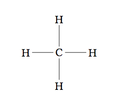Chemfig
Appearance
| Developer(s) | Christian Tellechea |
|---|---|
| Written in | TeX |
| Operating system | Cross-platform |
| Platform | LaTeX |
| Type | Chemical structure drawing |
| License | LaTeX Project Public License |
| Website | www |
Chemfig is a LaTeX package used for creating graphical representations of chemical structures, molecules, reaction schemes, and structural formulas. It provides a simple and flexible syntax to define atoms, bonds, angles, rings.[1] It allows for the construction of both organic and inorganic molecules using LaTeX markup.[2][3]
Features
[edit]- Customizable bond angles and lengths
- Support for single, double, triple, and aromatic bonds
- Cyclic compounds and ring structures
- Reaction arrows and mechanisms
- Integration with TikZ for advanced diagramming and mhchem for typesetting chemical equations
- Support for submolecules and nested chemical environments[4]
Syntax
[edit]Package preamble:
\input chemfig.tex
\usepackage{chemfig}
Chemfig uses a simple syntax based on TeX commands. For example:
\chemfig{H-C(-[2]H)(-[6]H)-C(=O)-OH}
Produces a structural formula for acetic acid and a structure would render as:

There are 9 different bond types:

\chemfig{A-B}\\
\chemfig{A=B}\\
\chemfig{A~B}\\
\chemfig{A>B}\\
\chemfig{A<B}\\
\chemfig{A>:B}\\
\chemfig{A<:B}\\
\chemfig{A>{{!}}B}\\
\chemfig{A<{{!}}B}\\

Molecular angles of a methane molecule:
\chemfig{C(-[:0]H)(-[:90]H)(-[:180]H)(-[:270]H)}
See also
[edit]- Comparison of TeX editors
- Computational chemistry
- Jmol - molecular modelling of chemical structures in 3 dimensions
- List of TeX extensions
- mhchem
- Molecular geometry
- Molecular graphics
- Overleaf - web app that does chemfig package chemical structures
- TikZ
- XyMTeX - another LaTeX structural formula package
References
[edit]- ^ "Chemistry formulae". www.overleaf.com.
- ^ "chemfig" (PDF). tug.ctan.org.
- ^ Wright, Joseph (August 25, 2012). "Exploring ChemFig: Basics". Some TeX Developments.
- ^ Brefo-Mensah, Eric K.; Palmer, Michael (October 2, 2012). "mol2chemfig, a tool for rendering chemical structures from molfile or SMILES format to LATE X code". Journal of Cheminformatics. 4 (1): 24. doi:10.1186/1758-2946-4-24. PMC 3551648. PMID 23031664.
